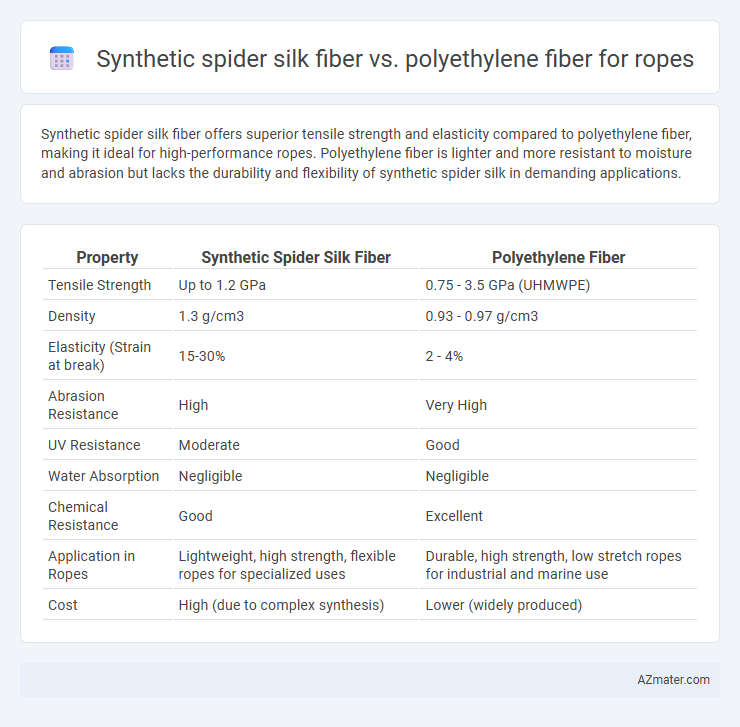Synthetic spider silk fiber offers superior tensile strength and elasticity compared to polyethylene fiber, making it ideal for high-performance ropes. Polyethylene fiber is lighter and more resistant to moisture and abrasion but lacks the durability and flexibility of synthetic spider silk in demanding applications.
Table of Comparison
| Property | Synthetic Spider Silk Fiber | Polyethylene Fiber |
|---|---|---|
| Tensile Strength | Up to 1.2 GPa | 0.75 - 3.5 GPa (UHMWPE) |
| Density | 1.3 g/cm3 | 0.93 - 0.97 g/cm3 |
| Elasticity (Strain at break) | 15-30% | 2 - 4% |
| Abrasion Resistance | High | Very High |
| UV Resistance | Moderate | Good |
| Water Absorption | Negligible | Negligible |
| Chemical Resistance | Good | Excellent |
| Application in Ropes | Lightweight, high strength, flexible ropes for specialized uses | Durable, high strength, low stretch ropes for industrial and marine use |
| Cost | High (due to complex synthesis) | Lower (widely produced) |
Introduction to Advanced Rope Materials
Synthetic spider silk fiber exhibits exceptional tensile strength, elasticity, and lightweight properties compared to traditional polyethylene fibers, making it a revolutionary material for advanced rope applications. Polyethylene fibers, widely used due to their durability and resistance to chemicals and moisture, offer excellent abrasion resistance but lack the superior toughness and flexibility of synthetic spider silk. The integration of synthetic spider silk in rope manufacturing promises enhanced performance in extreme conditions, including higher load-bearing capacity and improved longevity, advancing the development of next-generation rope materials.
What Is Synthetic Spider Silk Fiber?
Synthetic spider silk fiber is a bioengineered material designed to mimic the exceptional strength, elasticity, and lightweight properties of natural spider silk. Compared to polyethylene fiber commonly used in ropes, synthetic spider silk offers superior tensile strength and better durability under dynamic loads, making it ideal for high-performance applications. Its biocompatibility and environmental sustainability also set it apart from traditional synthetic fibers.
Polyethylene Fiber: Types and Uses
Polyethylene fibers, including ultra-high-molecular-weight polyethylene (UHMWPE), are highly favored for ropes due to their exceptional strength-to-weight ratio, resistance to abrasion, and chemical inertness. These fibers are commonly used in marine, climbing, and industrial ropes where durability and lightweight performance are critical. Unlike synthetic spider silk fibers, polyethylene fibers offer cost-effective mass production and outstanding resistance to moisture, making them ideal for harsh environmental conditions.
Mechanical Strength: Comparing Spider Silk and Polyethylene
Synthetic spider silk fiber exhibits superior tensile strength and elasticity compared to conventional polyethylene fiber, making it highly advantageous for rope applications requiring durability and flexibility. Spider silk's unique protein structure allows it to absorb more energy before breaking, resulting in a higher toughness value than polyethylene. While polyethylene fibers like high-density polyethylene (HDPE) offer excellent chemical resistance and abrasion resistance, synthetic spider silk outperforms in mechanical strength metrics such as tensile strength, toughness, and elongation at break.
Flexibility and Elasticity Performance
Synthetic spider silk fiber exhibits superior flexibility and elasticity compared to polyethylene fiber, making it highly suitable for rope applications requiring dynamic load absorption and resilience. The exceptional tensile strength combined with high elongation at break allows synthetic spider silk ropes to stretch without permanent deformation, enhancing durability under repetitive stress. In contrast, polyethylene fiber, while strong and lightweight, demonstrates lower elasticity and flexibility, which can limit performance in scenarios demanding high flexibility and energy dissipation.
Durability and Environmental Resistance
Synthetic spider silk fiber exhibits superior durability compared to polyethylene fiber, offering exceptional tensile strength and resistance to wear and abrasion, making it ideal for heavy-duty rope applications. Its molecular structure also provides remarkable environmental resistance, including resilience against UV radiation, moisture, and extreme temperatures, outperforming polyethylene fibers that tend to degrade under prolonged exposure to these conditions. The biodegradable nature of synthetic spider silk further enhances its environmental sustainability, contrasting with the non-biodegradable polyethylene fibers commonly associated with ecological concerns.
Weight and Density Analysis
Synthetic spider silk fiber exhibits a significantly lower density of approximately 1.3 g/cm3 compared to polyethylene fiber, which has a density around 0.95 g/cm3, making polyethylene lighter by weight. However, synthetic spider silk demonstrates superior tensile strength-to-weight ratio, providing enhanced durability and strength for ropes even at slightly higher densities. The choice between these fibers depends on specific application requirements, balancing the lightweight advantage of polyethylene with the exceptional mechanical properties of synthetic spider silk.
Sustainability and Biodegradability Factors
Synthetic spider silk fiber demonstrates superior sustainability due to its renewable production methods using bioengineered proteins, significantly reducing reliance on fossil fuels compared to polyethylene fiber derived from non-renewable petrochemicals. Biodegradability tests reveal that synthetic spider silk fiber decomposes naturally within months under composting conditions, contrasting with polyethylene fiber, which persists in the environment for hundreds of years, contributing to microplastic pollution. These factors position synthetic spider silk as a more environmentally responsible choice for rope manufacturing, enhancing circular economy initiatives and reducing ecological footprints.
Cost and Scalability in Rope Manufacturing
Synthetic spider silk fiber offers exceptional tensile strength and flexibility but remains significantly costlier than polyethylene fiber due to complex bioengineering and limited large-scale production. Polyethylene fiber, widely used in rope manufacturing, provides a cost-effective solution with established scalability, benefiting from mature industrial processes and abundant raw material availability. The high production costs and current scalability challenges of synthetic spider silk restrict its widespread adoption despite superior performance qualities.
Future Prospects: Spider Silk vs Polyethylene in Rope Applications
Synthetic spider silk fiber offers superior tensile strength, elasticity, and biodegradability compared to polyethylene fiber, making it a promising material for advanced rope applications. Ongoing research focuses on enhancing its production scalability and cost-efficiency, which could revolutionize industries demanding lightweight, high-performance ropes such as aerospace, military, and climbing. Polyethylene remains widely used due to its affordability and chemical resistance, but synthetic spider silk's potential for sustainable, high-strength ropes positions it as a future industry disruptor.

Infographic: Synthetic spider silk fiber vs Polyethylene fiber for Ropes
 azmater.com
azmater.com